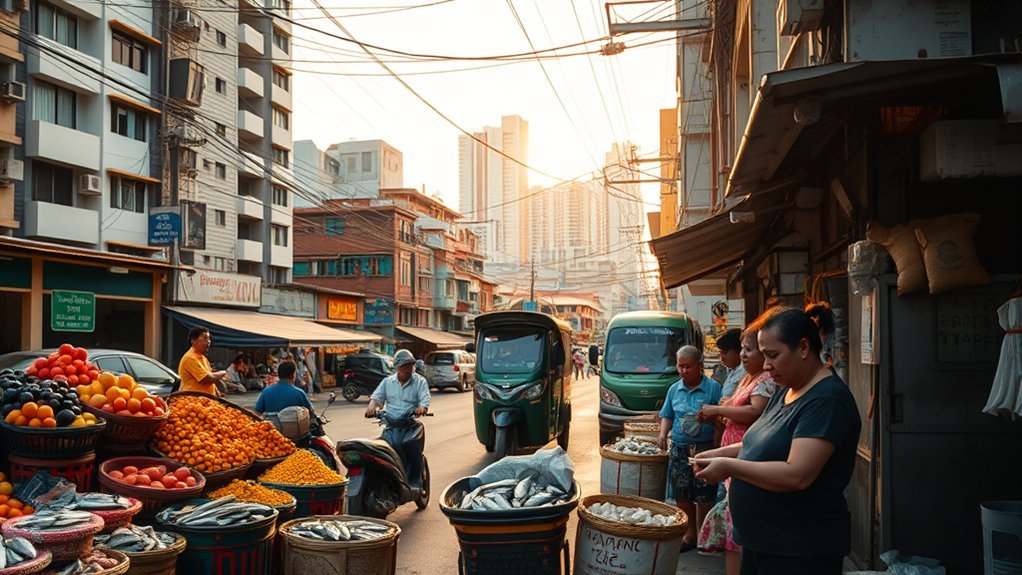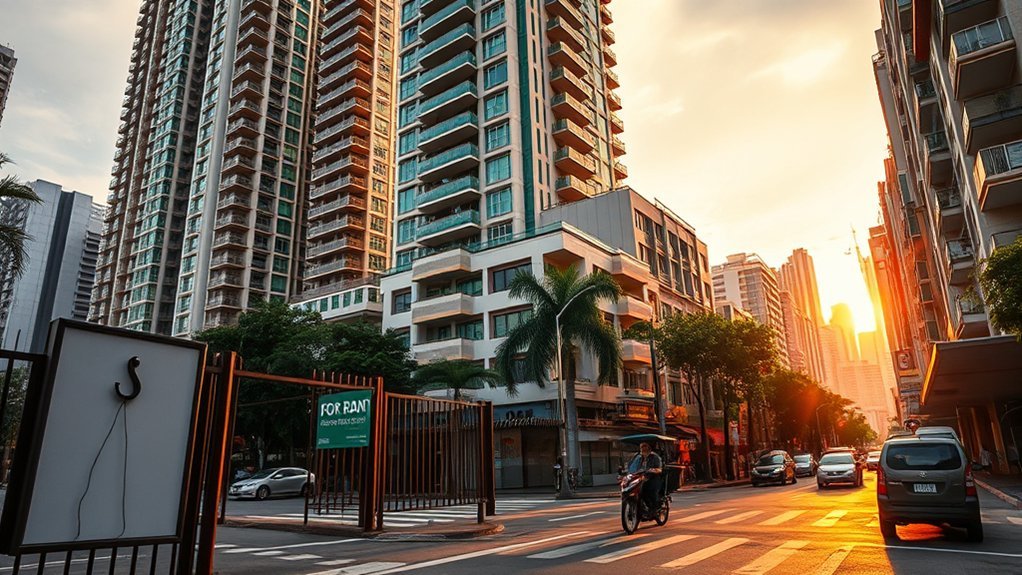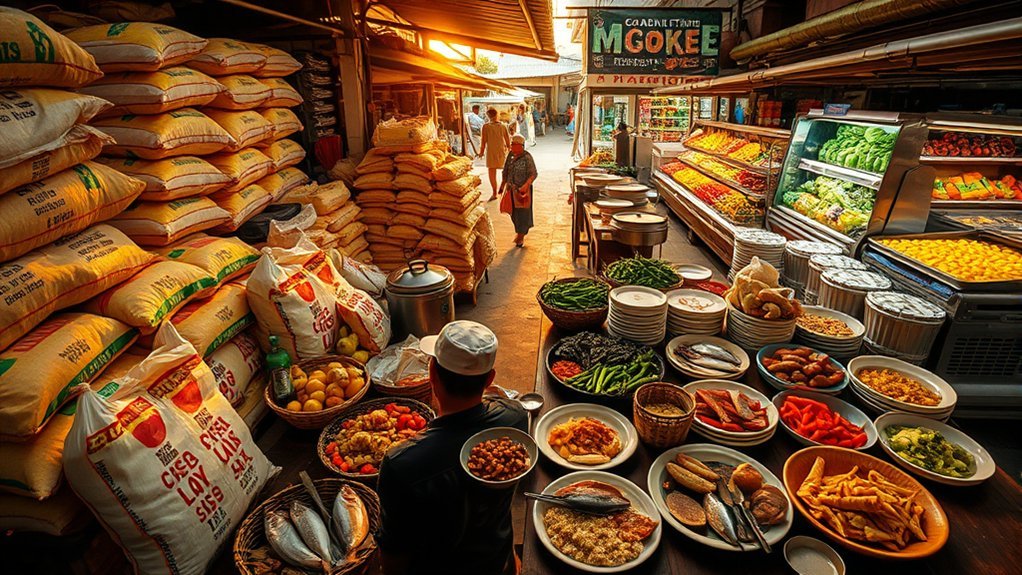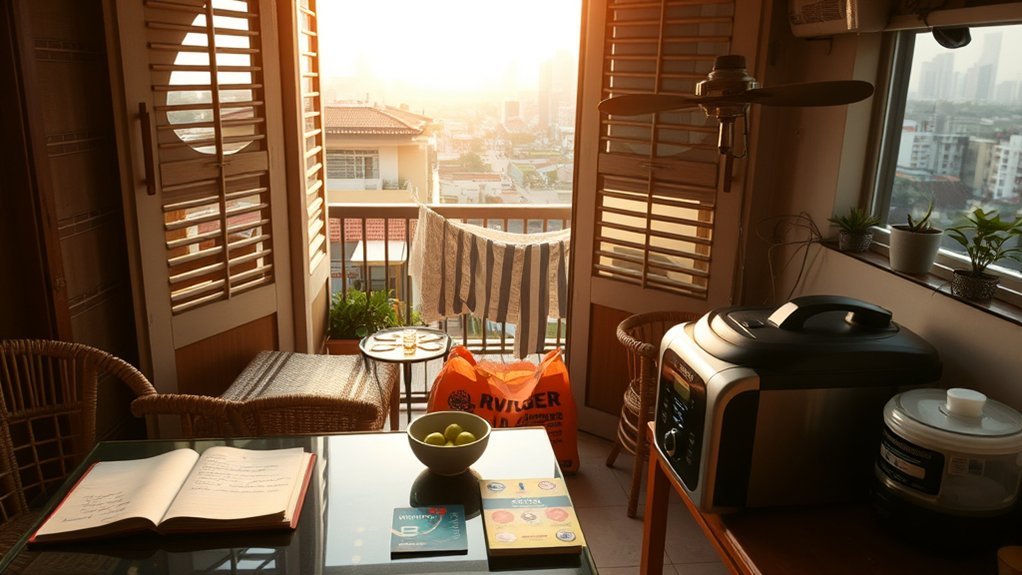You can live in the Philippines on roughly $600–$1,000 per month depending on city and lifestyle, with housing, food and transport as the main cost drivers. Expect rent to range from under $500 in smaller cities to about $850 in places like Cebu, utilities around $100, meals $3–$5 at local restaurants, and affordable public transit. Healthcare and schooling add extra costs, and practical tips can help you lower expenses if you want more details.
Key Factors That Determine Living Costs in the Philippines

While exact costs depend on where you live and how you spend, five main factors drive living expenses in the Philippines: housing, food, transportation, location (urban vs. rural), and lifestyle choices.
You’ll first notice the impact of housing expenses: city rentals vary widely — Cebu averages about $850/month while Davao runs under $500 — and that alone can push the average cost of living for expatriates to about $955 versus $614 for locals.
Food prices matter next: an average meal costs roughly $4.30 and a coffee about $1.22, so eating out stays affordable but adds up with frequency.
Transportation is cheaper than in many countries thanks to jeepneys and MRTs, reducing the need for a car.
Location amplifies all these factors — Manila and other big cities raise baseline costs, while rural areas lower them.
Finally, your lifestyle choices (housing standard, dining, and mobility) determine whether you fall above or below national averages.
Typical Monthly Budget Breakdown for Expats and Locals

Having looked at the main cost drivers, let’s lay out a practical monthly budget so you can see how those factors add up for expats versus locals.
On average, foreigners report monthly living expenses of about $955 while locals spend roughly $614. Housing is the largest single line item at about $485 for an average unit (note: housing specifics discussed later), leaving the remainder for food, transport, utilities and extras.
Food for expats averages $4.30 per meal; a daily three-meal plan plus occasional coffee (~$1.22) pushes monthly food to a sizable share of the budget.
Transportation is relatively low thanks to MRT, LRT and Jeepneys, so commuting costs stay modest versus owning a car.
In major cities like Cebu, expect higher totals—around $1,260 for expats and $869 for locals—driven by pricier services and discretionary spending.
Use these figures to map your planned lifestyle and adjust categories accordingly.
Housing Costs: Renting and Buying in Major Cities

You’ll find rental price ranges vary widely by city and neighborhood, from under $500 in Davao to about $850 on average for foreigners in Cebu and up to 80% cheaper than comparable U.S. rents.
When weighing buying vs renting, mortgage payments for downtown condos run roughly 53.5% lower than in the U.S., but longer-term 20-year mortgage rates are around 7% here versus 5.25% in the U.S., which affects overall cost.
Compare neighborhoods and amenities carefully — central one-bedroom units are about 84% cheaper than U.S. city centers, but location, security, and facilities will drive price differences.
Rental Price Ranges
Because rental and mortgage costs in the Philippines are measurably lower than in the USA, you can expect substantial savings whether you rent or buy: average rentals run up to 80% cheaper, one-bedroom city-center apartments can be about 84% less expensive, and suburban mortgage payments are roughly 65.9% lower; in practice that means foreigners in Cebu often pay around $850/month (locals about $869).
Davao rents commonly fall under $500/month, and overall housing budgets will look very different from U.S. benchmarks.
When living in the Philippines, you’ll find rental prices vary by city, neighborhood, and building quality.
For realistic budgeting you need to compare listings across platforms, factor utilities and association fees, and prioritize location versus amenities to match price expectations.
Buying Vs Renting
Wondering whether to rent or buy in Philippine cities? You’ll find clear, data-driven reasons both work.
Renting is far cheaper short-term; rent can be up to 80% lower than the USA, with one-bedrooms about 84% cheaper and three-bedrooms ~77% cheaper downtown.
Buying lowers monthly housing costs long-term: downtown condo mortgages average 53.5% less than U.S. equivalents, and suburban mortgages can be 65.9% lower.
- Visualize a compact downtown one-bedroom at 84% savings.
- Picture a three-bedroom downtown at ~77% reduced rent.
- Imagine mortgage payments downtown 53.5% below U.S. levels.
- See suburban mortgage savings up to 65.9%.
If you’re considering Living Abroad, Philippines offers strong affordability whether you rent or buy.
Neighborhoods and Amenities
Having looked at rent-vs-buy numbers, let’s look at where those savings play out across neighborhoods and amenities in major cities.
You’ll find downtown Cebu averages about $850/month, while Davao can be under $500, so location drives cost more than countrywide averages.
One-bedroom city-center apartments are roughly 84% cheaper than U.S. equivalents, and overall rentals can be up to 80% lower, which matters if you prioritize walkability, dining, and services.
If you’re buying, average mortgage payments for downtown condos run about 53.5% below U.S. levels; suburban homes are even cheaper, with mortgages about 65.9% lower—good for families wanting space and schools.
Use these differentials to match budget to neighborhood priorities.
Food, Groceries, and Dining Out Prices Across Regions

Although prices vary by region, you’ll find dining and grocery costs in the Philippines are generally low: a local restaurant meal runs about $4, a mid-range dinner for two around $14, and fast-food combo meals average $3.50 (roughly 70% cheaper than in the U.S.).
Dining and grocery costs in the Philippines are generally low: local meals ~$4, mid-range dinner ~$14, fast-food ~$3.50.
You can stretch your food budget easily: groceries are affordable, staples are cheap, and local cafes offer inexpensive coffee. Dining out for lunch is especially economical, often about 79% less than in the U.S., so you’ll eat well without overspending.
- Picture a street meal for $4 — flavorful, filling, and common.
- Imagine a $14 mid-range dinner — fresh seafood or Filipino favorites for two.
- Think of $3.50 fast-food combos — quick, consistent, and wallet-friendly.
- Visualize groceries: rice at $0.30/kg, bread $0.50/loaf, coffee $1.22/cup.
You’ll find regional variation, but data show food costs remain a reliable savings point for residents and expats.
Transportation, Utilities, and Communication Expenses

After enjoying how affordable eating out and groceries can be, you’ll find daily travel and household bills are also generally budget-friendly in the Philippines.
Monthly transportation costs are much lower: public transport passes run about 82% cheaper than in the USA, so commuting by bus, jeepney or train keeps your monthly spend down. Taxis are about 84% cheaper on average versus the USA, making occasional rides economical. If you drive, note gasoline is roughly 14% more expensive than in the USA, so vehicle ownership raises your costs relative to locals who use public transit.
Basic utilities—electricity, water and internet—vary by location and usage, but average around $100 monthly for a typical household. Expect higher electricity bills in hotter regions with heavy air-conditioning use.
Mobile communication is inexpensive: prepaid plans give affordable call and data options, letting you control spending tightly. Overall, transport and communication favor budget-conscious living, with utilities dependent on lifestyle and climate.
Healthcare, Education, and Insurance Considerations

Because healthcare costs are generally lower than in the USA, you can stretch your budget here—but quality varies widely, so plan carefully for where and how you’ll get care.
You should prioritize international health insurance that covers routine care, specialists, and emergency medical evacuation; premiums are an essential line item for expats.
Private hospitals near Manila offer reliable services, so identify and establish contacts there if you need higher-quality care.
Education is another predictable expense: average monthly schooling per child is about $272, so include that in family budgets or savings plans.
If you’re a retiree, look into the Special Resident Retiree Visa (SRRV) for smoother access to healthcare options and local services.
- Map nearest private hospitals and specialists.
- Budget for international insurance + evacuation.
- Allocate ~$272/month per child for schooling.
- Consider SRRV benefits if retiring here.
Use these data points to create a practical, prioritized plan for medical and education costs.
Practical Tips for Lowering Your Cost of Living in the Philippines

To cut monthly costs, focus on smart grocery shopping by using local ingredients like rice (about 78% cheaper than in the USA) and buying at markets rather than supermarkets.
Use public transport—MRT, LRT, and jeepneys—to slash commuting expenses (public passes can be ~82% cheaper than U.S. equivalents).
And when renting, negotiate firmly—average rents can be up to 80% lower than in the USA, so you’ve room to secure better terms or added utilities.
Smart Grocery Shopping
Start by making a grocery plan that leans on three habits proven to cut costs: buy staples in bulk, shop local wet markets for fresh produce and meat, and sync your meals with weekly sales and seasonal items.
You’ll reduce unit costs and eat fresher food by doing three things consistently.
- Visualize a month’s staples: rice sacks, canned goods, cooking oil — lower per‑kg price.
- Picture morning wet markets: seasonal mangoes, greens, and pork at market rates.
- Imagine weekly flyers: plan dinners around discounted proteins and canned items.
- See a loyalty card: accumulate points, redeem for staples or discounts.
Use data (unit prices, weekly promos, season calendars) to schedule bulk buys and weekly shopping trips.
Use Public Transport
After tightening your grocery budget, you can shave even more off monthly expenses by relying on public transport — the Philippines’ buses, MRT/LRT lines and jeepneys offer far lower costs than owning a car.
Expect monthly transport spending to be up to 82% lower when you use public options and commuter passes instead of maintaining a private vehicle. Single rides and passes are inexpensive; taxis are also economical, roughly 84% cheaper than U.S. averages, useful for off-peak trips or when you need door-to-door service.
Infrastructure upgrades have improved station access and route maps, so you’ll navigate faster and more reliably. Track routes, buy monthly cards where available, and combine jeepney legs with rail to minimize transfers and total travel time and cost.
Negotiate Rent Carefully
Because housing is often the biggest monthly expense, negotiate rent carefully to lock in the biggest savings possible — you can often get rates up to 80% lower than comparable U.S. properties and benchmark offers against city averages (for example, foreigner-friendly units in Cebu average about $850/month).
Use local data and timing to strengthen your position: landlords cut rates for long-term stays and off-peak moves. Consider suburbs where rents can be up to 88% cheaper than city centers.
- Tour comparable units and note listed prices to show market knowledge.
- Offer a longer lease in exchange for a lower monthly rate.
- Propose reduced deposit or waived fees if you have strong references.
- Time negotiations during slower rental months for better leverage.
Frequently Asked Questions
How Much Do I Need to Live Comfortably in the Philippines?
You’ll need about $955 per month to live comfortably as a foreigner in the Philippines, covering housing, food, transport, healthcare, and extras; you’ll save if you’re local, where about $614 typically suffices.
Can US Citizens Live in the Philippines?
Yes — you can live in the Philippines using visas like the SRRV; you’ll need to meet deposit and eligibility rules, enjoy English-friendly communities, lower living costs, and access international schools and healthcare for smoother relocation.
Is $500 a Lot of Money in the Philippines?
Yes — $500 stretches in many Philippine areas, especially outside Manila. You’ll cover basic rent, food, and utilities in smaller cities, though you’ll need tight budgeting and will limit dining out, entertainment, and higher-cost urban comforts.
Is It Expensive for an American to Live in the Philippines?
No — you won’t ruin your wallet; costs are far lower than in the US. You’ll pay dramatically less for rent, food, and transport, but you’ll still want international health insurance and budget for occasional imported goods.
Conclusion
Living in the Philippines can be surprisingly sensible: savvy spending slashes costs, starting with smart selection of city, sensible shared housing, and seasonal shopping to save on staples. You’ll cut commuting costs by choosing central neighborhoods and can compare clinics and insurance for better health value. Prioritize practical plans—prioritize price, place, and portability—so you preserve your purchasing power, protect your pocketbook, and prosper with predictable, data-driven decisions.


